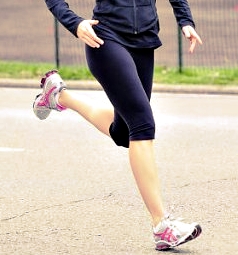Obese people may experience less aches, pain, and injuries by avoiding heel strike when running. The good news is obese runners run safer with forefoot running than with heel strike running because forefoot running reduces body loads and protects the knees.
2 Reasons Heel Strike Running is Bad for Obese Runners
Heel strike running was found to produce an impact transient which is not produced in a forefoot strike. The heel strike-impact transient increases with body weight and speed.
- the heavier you are, the greater the impact transient. The faster you run, the greater the impact transient.
Will a cushioned heel running shoe protect against the impact transient at heel strike?
Unfortunately, shoe cushioning has little effect on reducing the impact transient. This is obvious because the impact transient is linked to repetitive stress injury and the injury rate in joggers is consistently high despite wearing cushioned heeled shoes.

#2. Abnormal Pressure Pattern Over Foot.
At heel strike, the center of pressure (COP) occurs on the lateral aspect of the heel and rapidly moves medially up the foot to the 1st and 2nd metatarsal head (shown right).
The heavier the heel striker, the greater the COP applied on the foot, especially on the 1st and 2nd metatarsals which are linked to poor shock absorption.
Predictions have been made on stress fracture development in heel strikers with respect to the distribution pattern of the COP on the medial forefoot.
- as the body weight transfers over the foot during foot-rollover in heel running, prior to toe-off, the COP distributes abnormally over the 1st and 2nd metatarsal heads, increasing vulnerability to fatigue fracture.
Adopting a forefoot strike prevents abnormal distribution of the COP on the foot and supports why barefoot runners land with a forefoot strike, not a heel strike.
- in forefoot running, the COP begins under the 5th and 4th metatarsal head, dissipates over the rest of the forefoot, traveling and ending at the heel where pressure is significantly low.
- a proper forefoot strike is a flatter foot-placement and provides a larger surface area for the COP to dissipate evenly and safely.
Less Work on the Knee in Forefoot Running
In forefoot running, the ankle plantar-flexors absorb much of the shock at foot strike thereby reducing global impact on the body, particularly at the knee joint. This may suggest the lower incidences of runners knee in habitual forefoot and barefoot runners.
Furthermore, proper forefoot running involves the knee’s to remain soft and slightly bent at foot strike. This form of increased knee compliance has been found to soften landings in barefoot runners.
In heel striking however, the knee is exposed to more shock where the magnitude of peak knee extensor moments is also greater than forefoot running.
Essentially, the knee is overloaded in heel striking because it’s used as a source of power for propulsion. The findings suggest the knee endures more mechanical in heel striking, which coincides with the high prevalence of knee injury in recreational runners, most of which heel strike.
Many obese individuals are afraid to run because they assume their body weight will cause them injury. But, it’s not how much you weight that’s the problem, its how your body interacts with the ground while running that determines injury.
Novacheck reported that most of the injuries in running occur as a result of the high impact forces at the time of heel strike.
A fairly straightforward, simplistic conclusion to this would be eliminated heel strike to eliminate peak impact and therefore reduce the risk of injury.
Since forefoot running eliminates impact transients and body loading, forefoot running allows for a safer interaction with the ground. With proper instruction and gradual progression, forefoot running allows obese runners to run consistently, pain-free which in turn leads to consistent results on weight-loss.
More From Run Forefoot:
- Heel Striking is Dangerous
- How to Forefoot Strike
- Strengthening Exercises for Forefoot Running and Barefoot Running
- Forefoot Running Shoe Review
Run Forefoot, because you are faster than you think!
References:
Cavanagh PR. The biomechanics of lower extremity action in distance running. Foot Ankle 1987;7(4):197–217.
Lieberman, DE. Foot strike patterns and collsion forces in habitually barefoot versus shod runners. Nature 2010:463: 531-535.
Novacheck, TF. The biomechanics of running. Gait and Posture 1998; 7:77-95.
Bretta Riches
BSc Neurobiology; MSc Biomechanics candidate, ultra minimalist runner & founder of RunForefoot. I was a heel striker, always injured. I was inspired by the great Tirunesh Dibaba to try forefoot running. Now, I'm injury free. This is why I launched Run Forefoot, to advocate the health & performance benefits of forefoot running and to raise awareness on the dangers of heel striking, because the world needs to know.
Latest posts by Bretta Riches (see all)
- Can You Run In Barefoot Shoes? Yes, But DON’T Heel Strike! - 21/07/2024
- Why Cushioned Running Shoes Are Really Bad for Your Feet - 19/07/2024
- Do Cushioned Running Shoes Cause Injuries? - 17/07/2024


Leave a Reply